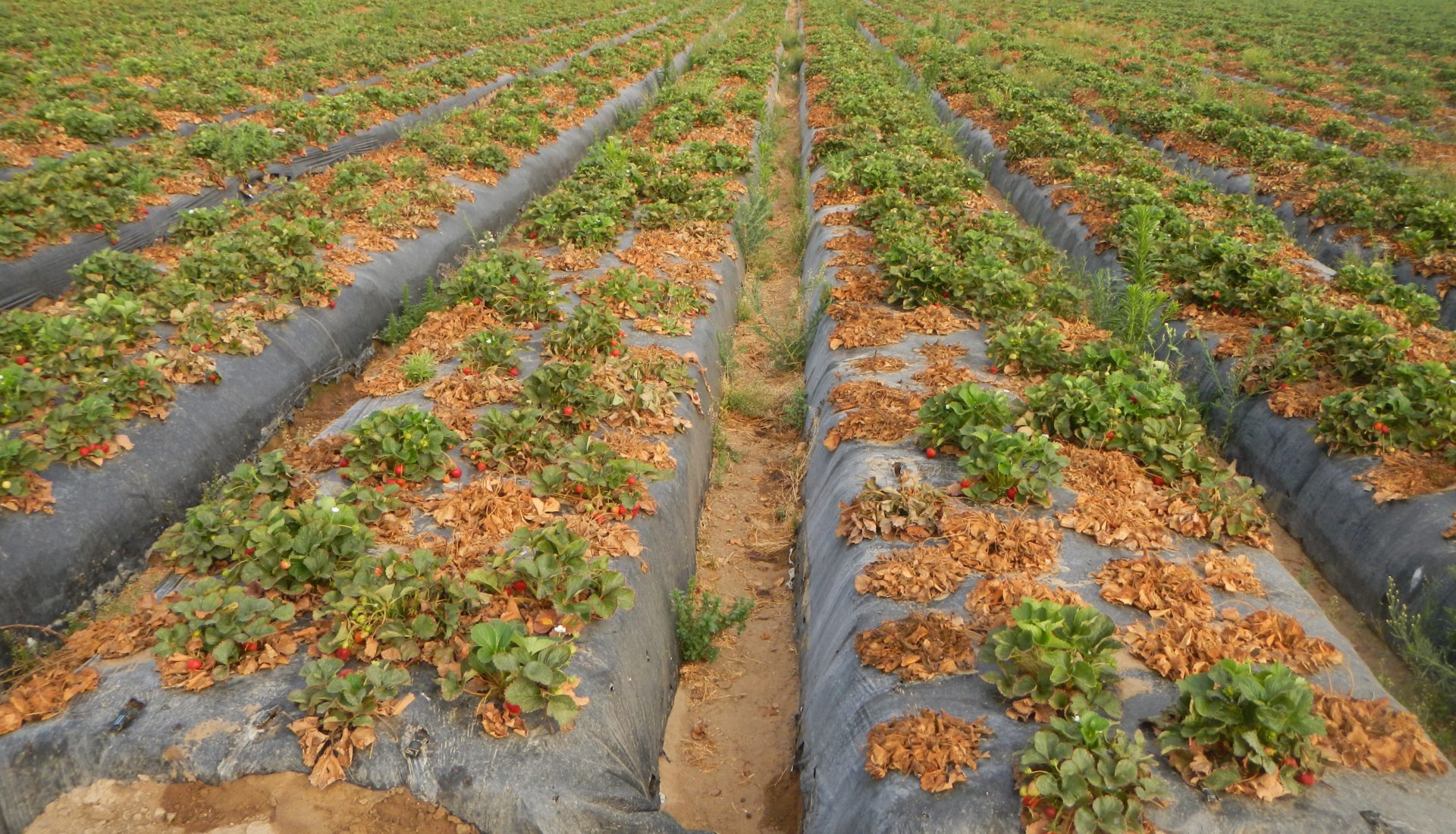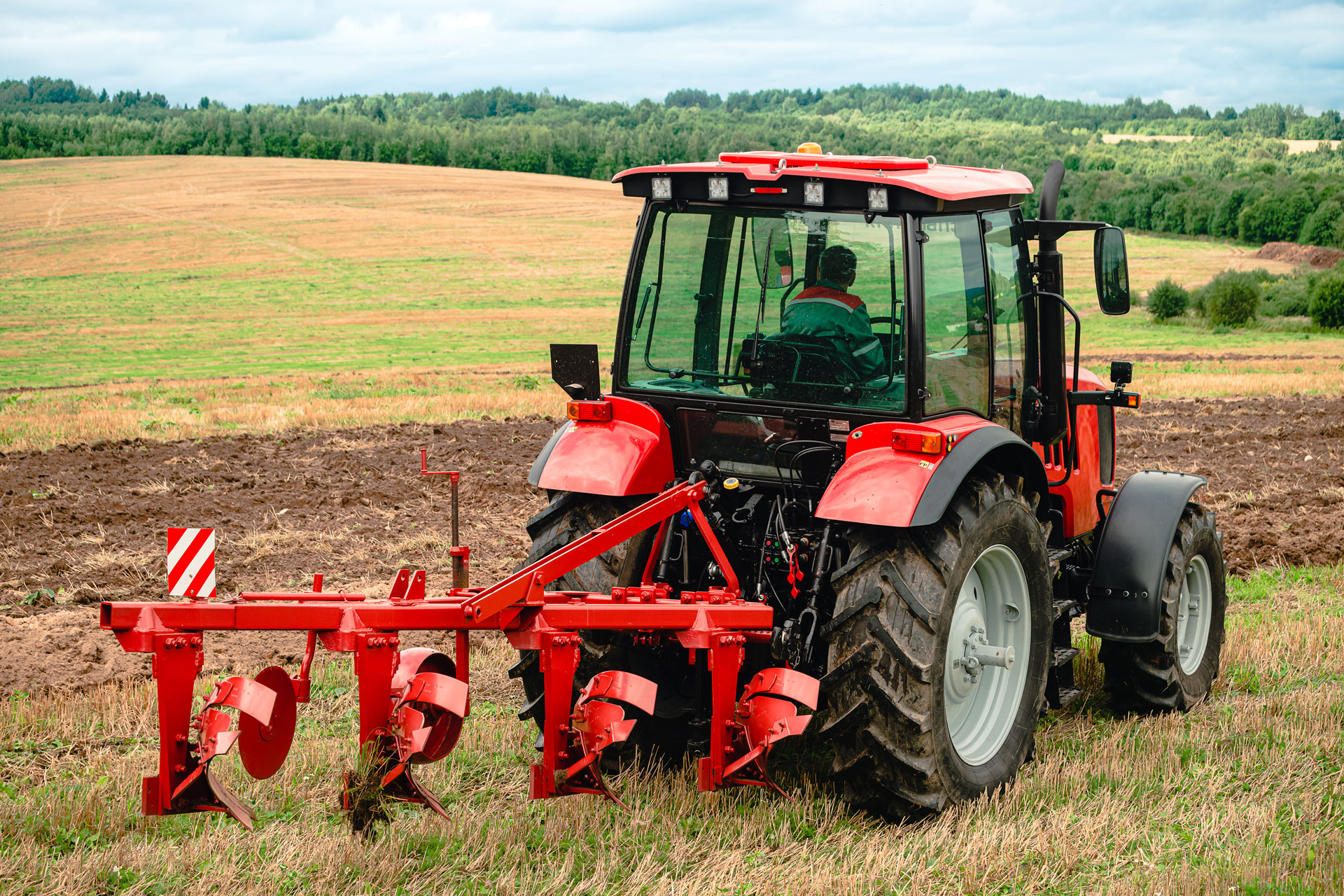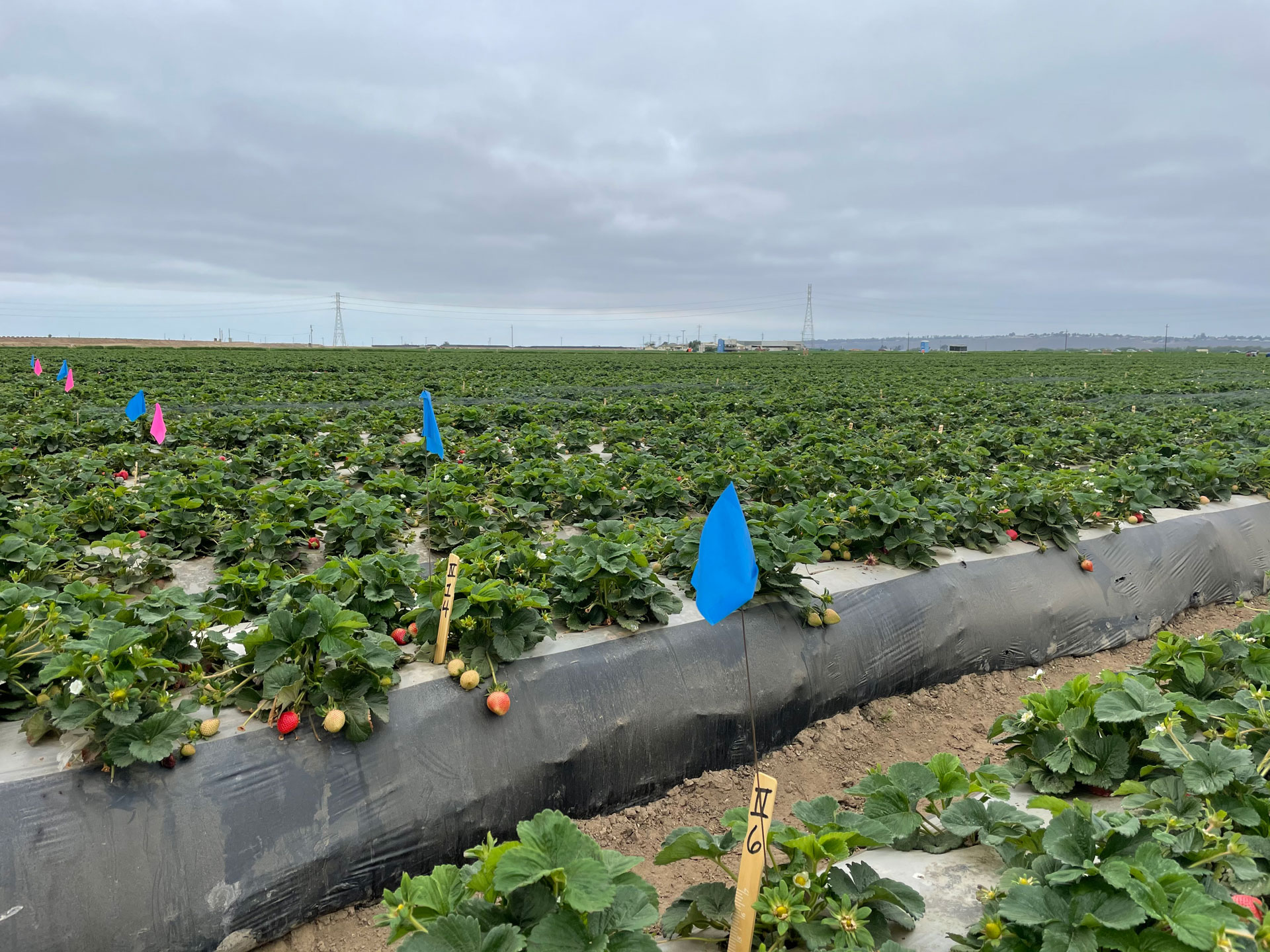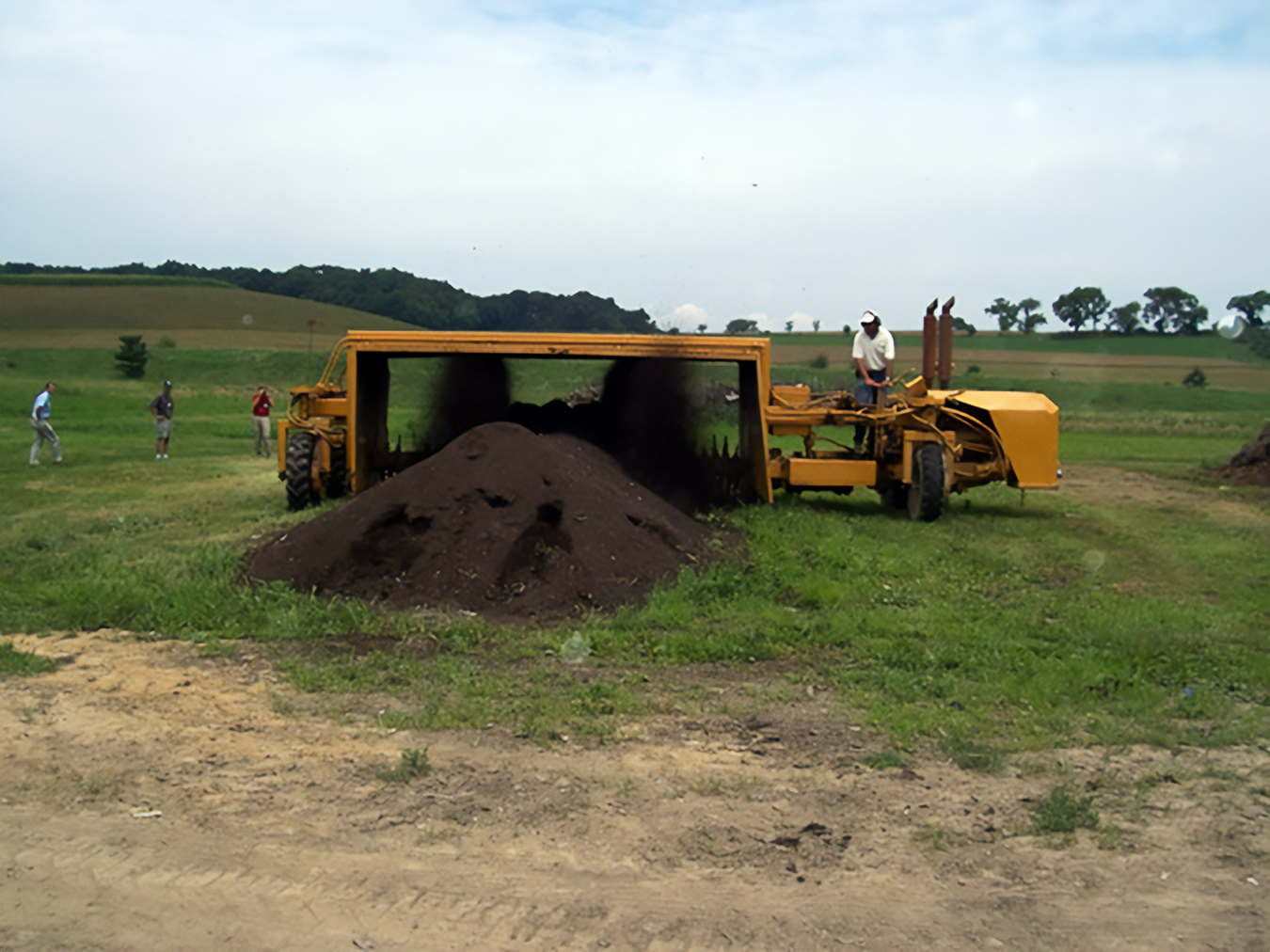
Soilborne diseases can cause devastating damage to strawberries. Most soilborne pathogens are lethal to this crop; fungal pathogens in the soil infect plants via roots and can impact the ability of the plant to uptake nutrients and water, causing a wilt symptom in leaves and stems in the early- to mid-harvest period. Fruit yield of infected plants is severely reduced, and the plants often die off eventually. Other soilborne pathogens, known as “root nibblers,” do not kill plants, but stunt them and likewise reduce fruit yield.
Soilborne disease management in organic strawberry production is a challenge. Unlike conventional strawberry production, no fumigants are available, tools are limited and soilborne pathogens are spreading, especially in California. However, recent studies provide some potential approaches and hints for developing agroecological management strategies.
Described in this article are three lethal soilborne pathogens commonly found in strawberry production in California. Then four approaches to managing these pathogens in organic strawberry systems are discussed.

Know Your Enemies
Table 1 shows three common lethal soilborne diseases and the responsible pathogens in California strawberries. Verticillium wilt caused by Verticillium dahliae is a classic soilborne disease in strawberries. The disease was first reported in 1932 in California strawberries and was the most widespread soilborne disease in the state until recently. Methyl bromide + chloropicrin chemical fumigation was developed to control this disease in the 1950s. In the late 2000s, however, two other soilborne diseases emerged: Fusarium wilt caused by Fusarium oxysporum f. sp. fragariae (F.o.f.) and charcoal rot caused by Macrophomina phaseolina. These pathogens were first reported in the southern production region and are now spread across the entire state, becoming a larger threat to the California strawberry industry.

These three pathogens have different characteristics (Table 1). First, the plant hosts differ between the three fungi; V. dahliae is known to infect more than 400 plant species, including 100 weed species, whereas F.o.f. and M. phaseolina (Koike et al., 2016) only infect strawberries. Second, the soil survival period varies; V. dahliae can survive in the soil without a host plant for an extended period (8-10 years) compared to F.o.f. and M. phaseolina (< 3 years.) Third, F.o.f. and M. phaseolina can survive in soil as saprophytes, meaning that these pathogens can feed not only on living plants but also can colonize dead organic matter such as crop residues and some organic amendments (e.g., rice bran, almond shell.) In contrast, V. dahliae does not have the ability to persist in soil as a saprophyte.
Understanding the characteristics of pathogens, the enemies, is crucial for developing a soilborne disease management strategy in organic strawberry production, as discussed below.
Diagnosing the Pathogen
If there are any symptomatic plants in your organic strawberry field, the first step in disease management is to determine the primary cause of symptomatic plants. Since each pathogen has different characteristics as mentioned above, it is vital to identify the specific pathogen(s) causing the wilt symptom. Unfortunately, wilt symptoms caused by these three soilborne pathogens are almost identical, and confirmation by visual observation is impossible even with the eyes of well-trained plant pathologists (see figure 1). Fortunately, recent developments in molecular approaches are making rapid and accurate determination of plant pathogens a reality.

This advance in pathogen identification is available for strawberry plant samples. The molecular method for identifying all three pathogens mentioned above in plants is now available at public and commercial plant pathology labs. The analysis can be done in a matter of hours.
The molecular test for soil samples is becoming available as well. For soil tests, however, not only is a quick and accurate detection method needed but also an economic threshold number above which crop yield decreases. At this time, among the three pathogens, V. dahliae is the only one for which both the molecular-based quantitative method and the threshold are developed. For M. phaseolina, a quantitative molecular approach has been established but no threshold developed. For F.o.f., only a qualitative molecular test is available and no threshold has been set. Active research is in progress in creating rapid and effective soil tests for these and other soilborne pathogens.
Organic Management Practices
Once the pathogen is identified, the next step is to develop an appropriate management strategy. Described here are four organically acceptable practices that can be implemented to mitigate soilborne diseases: crop rotation, anaerobic soil disinfestation, the use of varieties resistant to these diseases and sanitation practices.
Crop rotation: Crop rotation is a traditional method used worldwide to avoid soilborne diseases in strawberries and other crops. By planting different crops sequentially in a field, the temporal crop diversity, rather than spatial crop diversity, of the field is increased. Since each crop encourages the growth of specific soilborne pathogens and microorganisms in the rhizosphere, this practice enhances diversity in the soil microbial community and reduces the populations of plant-specific soilborne pathogens. In the organic systems in the U.S., crop rotation is mandatory under the National Organic Program. In the E.U., Northeast U.S. and Canada, a minimum of a three-year break between two strawberry plantings on the same field is recommended.
In California organic strawberries, back in the 1990s, crop rotation with at least a three-year break between each strawberry planting was the only approach used to avoid soilborne diseases. This strategy works best for soilborne pathogens that only infect strawberries (e.g., F.o.f. and M. phaseolina.) Anecdotal evidence indicates that at least a two-year break is necessary to avoid or reduce Fusarium wilt in strawberries on the central coast of California.
However, the long break period itself is not enough to suppress soilborne pathogens hosted by multiple plants. V. dahliae is the prime example of this challenge. For managing this pathogen, avoiding non-strawberry host plants during the break period is essential. Table 2 provides examples of host and non-host crops of V. dahliae, which highlights some major vegetable crops in California that are hosts of this pathogen. Further, about 100 weed species, including shepherd’s purse, dandelion, groundsel, nightshade and pigweed, also host this pathogen and make weed management an integral part of the soilborne disease strategy.

The good news is that studies found some crops actually suppress these pathogens. The effect of broccoli residue incorporation on suppressing V. dahliae in the soil is well-documented (Subbarao et al., 2007). After harvesting heads, leaves and stems are flail mowed and incorporated into the soil; breakdown of the broccoli residue results in a lowering of V. dahliae soil populations. This is a long-term strategy, and two or more broccoli crops may be necessary to start reducing the V. dahliae population in a highly infested field.
Preliminary studies by two independent labs showed that a specific variety of wheat appears to suppress M. phaseolina in the soil. A greenhouse study demonstrated that when strawberries were planted after growing different wheat varieties in soil infested with M. phaseolina, the variety Summit 515 was the most effective in suppressing this pathogen (Ivors, 2015). The practice is being used by some commercial growers and observationally seems to have an effect.
Recent studies from Asian countries demonstrated that Allium crops such as leeks and onions were effective in suppressing Fusarium oxysporum in spinach (Igarashi et al., 2017) and bananas (Huang et al., 2012). The biological mechanism of this suppression was also elucidated (Nishioka et al., 2019). A preliminary field trial in California is in progress to examine the effect of this approach in suppressing F.o.f. in strawberries.
Anaerobic soil disinfestation: Another tool for organic strawberry growers is a practice called anaerobic soil disinfestation (ASD.) ASD as a biological alternative to fumigation was developed independently in both the Netherlands and Japan around the year 2000. ASD creates the acid fermentation process in anaerobic soil in which toxic organic acids, volatiles and Fe2+ ions are produced, and microbial community shifts subsequently take place. This biologically mediated process suppresses a range of pathogens and nematodes in the soil. Over the last 15 years, ASD was examined extensively in California strawberry systems and proved to be effective in suppressing a range of soilborne pathogens. Today, over 1500 acres of organic berry fields in California are treated by ASD.
The standard ASD process involves multiple steps (see figure 2). During the ASD treatment, a total of approximately 1.5 acre-inches of water is applied via drip irrigation. After the treatment, planting holes are cut, and transplants are planted after one week. Both the level of anaerobic conditions (the stronger, the better) and soil temperatures (the warmer, the better) are keys for a successful ASD.

The three lethal soilborne pathogens each respond differently to ASD. In coastal California, ASD can suppress V. dahliae well under typical fall temperatures (Shennan et al., 2018). For F.o.f., however, ASD must be done in summer using clear plastic mulch. Using this approach, a study found a threshold of >460 hours above 86 °F at eight-inch soil depth is needed to suppress this pathogen on the central coast of California (Muramoto et al., 2020).
ASD should never be applied in the fall in coastal California to fields with a known history of Fusarium wilt. This saprophytic pathogen can grow on rice bran and result in increased populations under a lower soil temperature. This often results in higher levels of Fusarium wilt (see figure 3). Results on the effect of ASD on M. phaseolina are mixed so far, and more research is needed.

Resistant varieties: The use of resistant varieties can be the easiest and most reliable approach for a specific soilborne disease. Information on the level of soilborne disease resistance of the UC varieties is available at the California Strawberry Commission’s website calstrawberry.com/en-us/Pest-Management/Breeding. Note that there is no single variety that is resistant to all three soilborne pathogens. Also, currently there is a lack of a M. phaseolina resistant variety and a public variety with both excellent flavor and Fusarium wilt or charcoal rot resistance.
Sanitation practices: Basic sanitation practices such as washing soil off from tractors, equipment and tools are also critically important to avoid spreading soilborne pathogens. Sanitation and prevention are the key tools in soilborne disease management in organic strawberry production.
Integrated Disease Management
Soilborne disease management in organic strawberries requires an integrated approach. Based on the level and type of pathogens identified, or from the disease history of the site, a grower needs to develop an appropriate soilborne disease management strategy for the site by integrating available practices such as crop rotation, ASD and use of a resistant variety as well as basic sanitation of machines and tools to prevent the spread of soilborne pathogens from one field to another.
Well-designed crop rotation is the foundation of soilborne disease management in organic strawberry production. Diversified organic growers who grow strawberries as a core crop among many other crops may want to design their crop rotation around strawberries, one of the most soilborne disease-prone and lucrative crops. Specialized organic strawberry growers might not be able to control the crop rotation by themselves, but it is worth communicating with the vegetable grower with whom they rotate the field.
ASD is a useful tool when there is no choice but to plant strawberries after a Verticillium host crop such as lettuce. A resistant variety can be chosen as needed when it is acceptable for your market.
Tools for soilborne disease management in organic strawberries are still limited. Interactions between a crop plant and its microbiome, including pathogens and beneficial microbes, need to be better understood, and differences in microbiomes between varying crops need to be discovered. Armed with such science-based information, improved suppressive crop rotations may be able to be developed as well as ways to use microbial amendments more effectively. This soilborne disease management approach is knowledge-intensive and location-specific, which is in contrast with fumigation practices that are characterized by chemical-intensive and location-general approaches.

Acknowledgements: The author would like to thank valuable comments from Steve Koike, Kelly Ivors, Mark Bolda and Erin Foley to the previous version of the manuscript.
References:
California Strawberry Commission. 2020. University of California Strawberry Varieties’ Resistance. www.calstrawberry.com/en-us/Pest-Management/Breeding (accessed on 5/02/2020).
Huang, Y.H., Wang, R.C., Li, C.H., Zuo, C.W., Wei, Y.R., Zhang, L., Yi, G.J., 2012. Control of Fusarium wilt in banana with Chinese leek. Euro. J. Plant Pathology 134, 87-95.
Ivors, K. 2015. Suppression of Macrophomina with wheat? Presentation at UCCE Ventura County. Available at: ceventura.ucanr.edu/files/239434.pdf (accessed on 5/02/2020).
Igarashi, C., Asano, Y., Nishioka, T., Suga, H., Hyakumachi, M., Shimizu, M., 2017. Suppression of spinach Fusarium wilt by intercropping with Allium plants. Japanese J. of Phytopathology 83, 87-94.
Koike, S. T., Arias, R. S., Hogan, C. S., Martin, F. N., and Gordon, T. R. 2016. Status of Macrophomina phaseolina on strawberry in California and preliminary characterization of the pathogen. Int. J. of Fruit Sci. 16: 148-159.
Muramoto, J., Shennan, C., Mazzola, M., Wood, T., Miethke, E., Resultay, E., Zavatta, M., Koike, S.T., 2020. Use of a summer cover crop as a partial carbon source for anaerobic soil disinfestation in coastal California. Acta Hort. 1270, 37-44.
Nishioka, T., Marian, M., Kobayashi, I., Kobayashi, Y., Yamamoto, K., Tamaki, H., Suga, H., Shimizu, M., 2019. Microbial basis of Fusarium wilt suppression by Allium cultivation. Scientific Reports 9, 1715.
Shennan, C., Muramoto, J., Koike, S., Baird, G., Fennimore, S., Samtani, J., Bolda, M., Dara, S., Daugovish, O., Lazarovits, G., Butler, D., Rosskopf, E., Kokalis-Burelle, N., Klonsky, K., Mazzola, M., 2018. Anaerobic soil disinfestation is an alternative to soil fumigation for control of some soilborne pathogens in strawberry production. Plant Pathology 67, 51-66.
Subbarao, K.V., Kabir, Z., Martin, F.N., Koike, S.T., 2007. Management of soilborne diseases in strawberry using vegetable rotations. Plant Dis. 91, 964-972.





